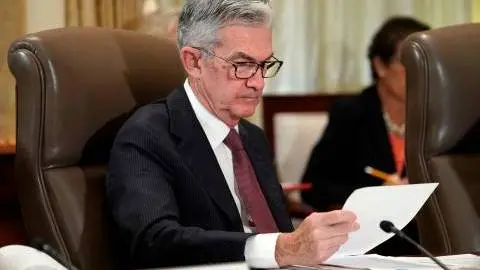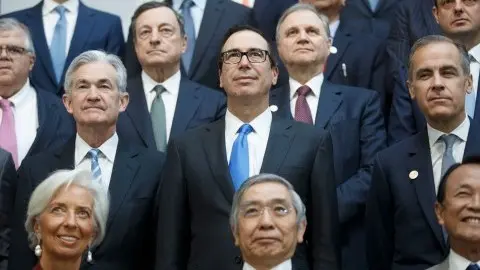FX intervention: Does President Trump have the means, motive and opportunity?
FX intervention is in the news after President Trump accused China and Europe of playing a ‘big currency manipulation game’ and suggesting the US should match it. Could frustration with the Fed prompt the President to take matters in his own hands and weaken the dollar?
FX intervention is back in the news (Bloomberg story count)

Beyond pressuring the Fed, how could the President weaken the dollar?
Given the overt pressure on the Federal Reserve to ease policy, it should come as no surprise that President Trump would like a weaker dollar to support the US economy. His problem is that he has few powers over domestic, let alone foreign monetary policy. He may bemoan Europe for keeping its currency weak through prior and perhaps future episodes of quantitative easing, but eurozone core inflation hasn’t been near the ECB’s 2% target since early 2008 and Washington can do very little to prevent another round of easing from the ECB.
It is possible, Washington may start to look at its own tools to weaken the dollar. There have been no direct suggestions from the White House so far, but tweets regarding the need to match the currency manipulation of other trading partners have the market speculating over whether President Trump would instruct the US Treasury to sell dollars and buy FX in a unilateral intervention.
Will the lure of a weaker dollar to support the US economy into 2020 prove to be too great for President Trump?
The issue of US FX intervention has also gained attention after a post from ex-US Treasury official and respected blogger, Brad Setser, a senior fellow at the Council on Foreign Relations, supporting calls for countervailing currency intervention (CCI) – effectively laying the groundwork for the US Treasury to sell dollars and buy currencies of those countries having been deemed to be manipulating their currencies lower for trade gains.
Given the President’s broad use of executive powers – including the obscure IEEPA law to block undocumented Mexican immigration – it is not too much of a jump for the White House to re-familiarise itself with available methods to influence FX rates. Even though, in theory, the US is still signed up, via the March 2018 G20 Communique, to refrain from competitive devaluations, but the lure of a weaker dollar to support the US economy into 2020 may be too great.
Here we look at whether the White House has the Means, the Motive and the Opportunity to engage in direct intervention to weaken the dollar.
The Means: Authority lies with the White House
When it comes to FX intervention, the authority to direct it certainly sits with the President. This derives through the 1934 Gold Act which established the Exchange Stabilisation Fund (ESF). This legislation gave power to the US Treasury and the President to deal in gold and FX ‘for the purpose of stabilising the exchange value of the dollar’. There have been several amendments to this law over time, but none to categorically change the position that the President can direct FX intervention.
It seems pretty clear that the authority for FX intervention sits neither with Congress nor the Fed, but with the President
Currently, the United States FX reserves are around USD 42bn, held exclusively in EUR and JPY. These are split equally between the Treasury’s ESF and the Fed’s SOMA account – effectively whenever the US Treasury instructs the Fed to intervene in FX markets, the Fed would undertake the mirror-image activity in both the ESF and SOMA accounts. Currently, FX reserves are roughly split 60:40 for EUR:JPY and 60:40 cash deposits: government securities.
Conceivably, the White House could tell the US Treasury to go out and buy several billion dollars’ worth of EUR and JPY to ‘stabilise the dollar’. In terms of which dollars get sold for this exercise, we presume the US$23bn worth of US government securities in the ESF may be untouchable. Instead, such activity would involve some money creation from the Fed, given that issuing Treasury debt for FX purposes (as Carter did in 1978) would probably have to go through Congress – something the White House would want to avoid.
However, in short, it seems pretty clear that the authority for FX intervention sits neither with Congress nor the Fed, but with the President.
USD 42bn of US FX reserves are in EUR and JPY

The Motive: Trading partners aren’t playing fairly
President Trump hasn’t minced his words about currency manipulation. Europe and China are certainly in the firing line here and the White House’s motives – as Brad Setser rightly points out – are that if the US economy slows and the Fed cuts rates, the US export sector should be able to benefit from a weaker dollar without trading partners preventing an adjustment in their currencies through intervention. Yet the ECB has never intervened to buy FX and the People's Bank of China has probably not done so for five years.
Currently, the US Treasury’s foreign currency report is still the vehicle for assessing currency manipulation and the next report is not due until mid-October. Instead, and we’re speculating here, perhaps the White House assesses the US needs larger FX reserves to maintain the stability of the dollar.
Enjoying the ‘exorbitant privilege’ of issuing debt in the world’s most popular reserve currency, the US typically doesn’t succumb to FX reserve adequacy analysis. However, if President Trump looks for opportunities to artificially dampen the value of the dollar, he may look at some international comparisons.
If US FX reserves were to match those of the eurozone in terms of GDP, the US would require an extra USD 400bn worth of foreign currency
In terms of size, the FX reserves-to-GDP ratio for the United States is a miniscule 0.2%. The most commonly used metrics of reserve adequacy, which take into account the short-term debt and the current account deficit, also shows the US with very small FX reserves.
The reason, of course, stems from the fact the US is itself the issuer of the dollar which accounts for most of the FX reserves worldwide. The “infinite” stockpile of USD makes it unnecessary for the US to hold massive reserves. Nevertheless, the Trump administration might point a finger at the eurozone. Were US FX reserves to match those of the eurozone in terms of GDP, the US would require an extra USD 400bn worth of foreign currency.
FX reserves as a % of GDP (US reserves are small)

The Opportunity: Could ECB action trigger a Washington response?
President Trump’s twitter finger has been very sensitive to the ECB policy and the EUR. Were the ECB to cut rates in late July or enact a fresh round of quantitative easing in September – such that EUR/USD comes under fresh pressure – Washington could potentially respond. At this time the trade weighted dollar could well be retesting its all-time high.
Alternatively, the US Treasury could again move the goal-posts in its currency manipulation report – next report due mid October – laying the groundwork for direct FX intervention. Under this approach, however, it is hard to see how the US could penalise Europe unless currency manipulation criteria witness wholesale changes.
US trade weighted dollar near the highs

Intervention threat to limit the dollar's upside
Dollar strength or least the weak currencies of key trading partners of the US are certainly on Washington’s radar. So far the White House has exerted indirect pressure on the dollar via the need for Fed easing. If the dollar doesn't start to fall later in the year, we suspect pressure will grow for the US Treasury to take more direct action on the dollar.
The wild-card of FX intervention is another reason why we prefer the dollar to be topping out this summer and retain year-end forecasts for EUR/USD and USD/JPY at 1.15 and 103 respectively.
Download
Download article
8 July 2019
What’s happening in Australia and the rest of the world? This bundle contains 9 ArticlesThis publication has been prepared by ING solely for information purposes irrespective of a particular user's means, financial situation or investment objectives. The information does not constitute investment recommendation, and nor is it investment, legal or tax advice or an offer or solicitation to purchase or sell any financial instrument. Read more


